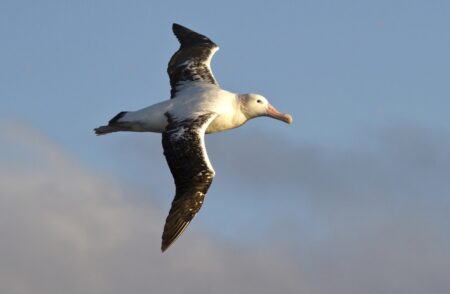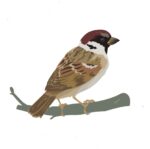What Is The Biggest Flying Bird?
The world of birds is home to a vast variety of species, ranging in size from tiny hummingbirds to giant condors. But when it comes to the largest birds that can take to the skies, there is one that stands out above the rest. It has a wingspan that can reach up to 11.5 feet and weighs more than 25 pounds. This magnificent bird is known as the Wandering Albatross and it is considered the biggest flying bird in the world.
The Wandering Albatross has a wingspan of up to 11.5 feet and can weigh up to 25 pounds. This impressive bird is found in the Southern Hemisphere and is known for its powerful soaring abilities, allowing it to travel long distances without flapping its wings. Other large flying birds include the Andean Condor, the Kori Bustard, and the Great Bustard. Flying birds have evolved unique adaptations to achieve flight, such as lightweight, hollow bones and large, powerful wings. Despite their size, these birds are graceful and efficient fliers and are able to cover vast distances in search of food and suitable habitats.
What Is The Biggest Flying Bird?
The biggest flying bird is the wandering albatross, also known as the wandering or snowy albatross. It has a wingspan of up to 11.5 feet (3.5 meters) and can weigh up to 25 pounds (11 kilograms). They are found in the Southern Ocean and breed on remote islands such as South Georgia, the Falkland Islands, and Macquarie Island in the southern Indian and Pacific Oceans. They are known for their incredible flying abilities and can glide for hours without flapping their wings, using their long, narrow wings to catch the wind and stay aloft. Due to their large size, they have adapted to a life at sea and only come to land to breed. They feed on fish, squid, and krill, and can travel long distances in search of food. The wandering albatross is an endangered species, with only an estimated 25,000 to 50,000 individuals remaining in the wild.
Top 10 Biggest Flying Birds in The World
- Wandering Albatross: The Wandering Albatross is the largest flying bird in the world with a wingspan of up to 12 feet. It can weigh up to 25 pounds and is found primarily in the Southern Hemisphere. They are known to glide for hours without flapping their wings, using their long, narrow wings to catch the wind currents.
- Andean Condor: The Andean Condor is one of the heaviest flying birds, with a weight of up to 33 pounds. It has a wingspan of up to 10 feet and is found in the Andes Mountains in South America. They are known for their distinctive white collar and black feathers.
- Kori Bustard: The Kori Bustard is the heaviest flying bird in Africa, weighing up to 42 pounds. It has a wingspan of up to 9 feet and is found in the grasslands and savannas of sub-Saharan Africa. They are known for their elaborate mating displays, where males inflate their throats and puff up their feathers.
- Great White Pelican: The Great White Pelican is a large water bird with a wingspan of up to 10 feet. It is found in wetlands and shallow lakes in Africa, Europe, and Asia. They are known for their impressive fishing abilities, using their large bills to catch fish.
- Trumpeter Swan: The Trumpeter Swan is the largest waterfowl in North America, with a wingspan of up to 8 feet. It can weigh up to 30 pounds and is found in ponds, lakes, and marshes in the northern parts of the continent. They are known for their deep, resonant calls that can be heard for miles.
- Dalmatian Pelican: The Dalmatian Pelican is the largest of all pelican species, with a wingspan of up to 11 feet. It can weigh up to 33 pounds and is found in lakes and rivers in Europe and Asia. They are known for their distinctive yellow pouches and impressive diving abilities.
- Cinereous Vulture: The Cinereous Vulture, also known as the Eurasian Black Vulture, has a wingspan of up to 10 feet and can weigh up to 30 pounds. It is found in Europe, Asia, and Africa and is known for its scavenging abilities, often feeding on carcasses of large animals.
- Greater Rhea: The Greater Rhea is the largest bird in South America, with a wingspan of up to 6 feet and weighing up to 40 pounds. It is flightless but is able to run at speeds of up to 40 miles per hour. They are found in open grasslands and savannas in Brazil, Argentina, and other countries in South America.
- Australian Bustard: The Australian Bustard is the largest bird in Australia, with a wingspan of up to 8 feet and weighing up to 20 pounds. It is found in grasslands and savannas in the northern parts of Australia and is known for its elaborate courtship displays, where males puff out their necks and make deep, booming calls.
- Mute Swan: The Mute Swan is a large water bird with a wingspan of up to 8 feet and weighing up to 30 pounds. It is native to Europe and Asia but has been introduced to North America. They are known for their graceful appearance and are often seen swimming in pairs or family groups.
SEE ALSO: Is Penguin A Bird?
Largest Flying Birds of Prey
- Andean Condor (Vultur gryphus): The Andean condor is the largest flying bird of prey in the world, with a wingspan of up to 10.5 feet and a weight of up to 33 pounds. It is found in the Andes Mountains of South America and is distinctive for its large size and black and white plumage. The Andean condor is a carrion feeder, using its keen eyesight and sharp beak to scavenge for food.
- California Condor (Gymnogyps californianus): The California condor is another species of condor found in North America. It has a wingspan of up to 9.8 feet and can weigh up to 26 pounds. It has a black body with white patches under its wings and a pink, bald head. The California condor is critically endangered, with only about 500 individuals left in the wild.
- Steller’s Sea Eagle (Haliaeetus pelagicus): The Steller’s sea eagle is one of the largest birds of prey in the world, with a wingspan of up to 8 feet and a weight of up to 20 pounds. It is found in coastal areas of northeast Asia and is recognized by its distinctive white head and black and white plumage. It primarily feeds on fish and is considered a threatened species due to habitat loss and hunting.
- Eurasian Black Vulture (Aegypius monachus): Also known as the monk vulture, the Eurasian black vulture is the largest bird of prey in Europe, with a wingspan of up to 9 feet and a weight of up to 33 pounds. It has a black and white body, with a bald, reddish head. The Eurasian black vulture feeds on carcasses and is found primarily in southern Europe and Asia.
- Cinereous Vulture (Aegypius monachus): The cinereous vulture, also known as the black vulture, is found in Europe, Asia, and Africa. It has a wingspan of up to 9.5 feet and can weigh up to 31 pounds. It is dark brown in color with a bald, pink head. The cinereous vulture is a scavenger, feeding on carcasses, and is classified as a near-threatened species.
- Harpy Eagle (Harpia harpyja): The harpy eagle is found in the rainforests of South and Central America and is characterized by its impressive size, with a wingspan of up to 6.5 feet and a weight of up to 20 pounds. It has a grey and black body with distinct facial feathers, earning it the name “flying wolf” in some regions. The harpy eagle preys on small mammals and large birds.
- Philippine Eagle (Pithecophaga jefferyi): The Philippine eagle is found exclusively in the Philippines and is known for its striking appearance, with a wingspan of up to 6.5 feet and a weight of about 14-20 pounds. It has a dark brown body with a distinctive white crest and bright blue eyes. The Philippine eagle is critically endangered, with only about 400 individuals left in the wild.
- White-tailed Sea Eagle (Haliaeetus albicilla): Also known as the Eurasian sea eagle, the white-tailed sea eagle has a wingspan of up to 8 feet and can weigh up to 17 pounds. It is found in Europe and Asia and is recognizable by its large size, white head and tail, and brown body. The white-tailed sea eagle feeds primarily on fish, but will also take small mammals and birds.
- Bald Eagle (Haliaeetus leucocephalus): The bald eagle is the national emblem of the United States and is found primarily in North America. It has a wingspan of up to 7.5 feet and can weigh up to 14 pounds. It is recognized by its distinctive white head and dark brown body. The bald eagle is a powerful hunter, feeding on fish, small mammals, and carrion.
- Golden Eagle (Aquila chrysaetos): The golden eagle is found in North America, Europe, and Asia and is one of the largest flying birds of prey in the world, with a wingspan of up to 7 feet and a weight of up to 15 pounds. It has a brown body and a golden-brown feathered head. The golden eagle is a powerful hunter, feeding on small mammals, birds, and even larger prey such as deer and mountain goats.
Largest Wingspan Bird
- Wandering Albatross: The wandering albatross has the largest wingspan of any living bird, measuring up to 3.5 meters (11.5 feet). These majestic birds are found in the Southern Ocean and are known for their long, graceful flights over the open seas. They have a solid build and long wings that help them take advantage of the powerful winds over the ocean.
- Great White Pelican: This large waterbird has a wingspan of up to 3.4 meters (11.2 feet). It is found in Africa, Europe, and Asia and is known for its elegant and effortless flight. The great white pelican is a colonial breeder, with huge flocks often seen soaring in the air together.
- Southern Royal Albatross: The southern royal albatross has a wingspan of up to 3.3 meters (10.8 feet). It is found in the sub-Antarctic regions and is closely related to the wandering albatross. Like its cousin, it has a long lifespan and spends most of its life in flight.
- Andean Condor: This vulture has a wingspan of up to 3.2 meters (10.5 feet) and is found in the Andean mountains of South America. It is a powerful flier, using thermals and air currents to soar high in the sky and search for carrion.
- Dalmatian Pelican: The Dalmatian pelican has a wingspan of up to 3.1 meters (10.2 feet) and is the largest of all pelican species. It is found in Europe, Asia, and Africa and is known for its striking appearance, with a bright red gular pouch under its bill.
- Great Bustard: The great bustard has a wingspan of up to 2.7 meters (8.9 feet) and is the world’s heaviest flying bird. It is found in open grasslands and farmlands of Europe and Asia. The male of this species performs elaborate courtship displays during the breeding season.
- California Condor: This critically endangered vulture has a wingspan of up to 2.9 meters (9.5 feet) and is found in the western United States and Baja California, Mexico. It was on the brink of extinction in the 1980s, with only 22 individuals left. Thanks to conservation efforts, the population has now increased to over 500 birds.
- Eurasian Black Vulture: The Eurasian black vulture has a wingspan of up to 2.8 meters (9.2 feet) and is native to Europe, Asia, and Africa. Like other vultures, it plays an important role in the ecosystem by cleaning up carcasses and preventing the spread of diseases.
- Marabou Stork: The marabou stork has a wingspan of up to 2.6 meters (8.5 feet) and is found in Africa. It is a large bird with a bare head and neck and is often seen scavenging for food alongside vultures.
- Bald Eagle: The bald eagle has a wingspan of up to 2.5 meters (8.2 feet) and is found in North America. It is the national bird of the United States and is known for its majestic and powerful flight. It is a skilled hunter and feeds mainly on fish and waterfowl.
Largest Flying Bird in The World Extinct
Quetzalcoatlus is a genus of pterosaur believed to be the largest flying animal to have ever lived. It lived during the Late Cretaceous period, around 68-66 million years ago. Its name is derived from the Aztec god Quetzalcoatl, meaning “feathered serpent”.
Size and Physical Characteristics:
Quetzalcoatlus was estimated to have a wingspan of up to 36 feet (11 meters) and a weight of around 550 pounds (250 kilograms). Its body was fairly small compared to its large wings, measuring only about 13 feet (4 meters) in length. This made it similar in size to a small airplane.
It is believed that Quetzalcoatlus had a long, thin beak and a relatively short neck. Its wings were proportionally longer and narrower than other pterosaurs, giving it a sleek appearance. It had four long, slender legs with sharp claws that were used for walking, taking off, and landing.
Habitat and Diet:
Quetzalcoatlus likely lived in a variety of habitats, including coastal regions and inland plains. It may have also frequented lakes and rivers, using its sharp beak to catch fish and other small prey.
Its diet is thought to have consisted mainly of small animals, such as small dinosaurs, lizards, mammals, and insects. Some scientists have also suggested that Quetzalcoatlus may have been a scavenger, feeding on the remains of larger animals.
Flight Capabilities:
Despite its massive size, Quetzalcoatlus was capable of flying. It had a light but strong skeleton, and its wings were supported by long, thin bones similar to those of modern birds. Its wings were also covered in feathers, similar to other pterosaurs, which would have helped with insulation and aerodynamics.
It is believed that Quetzalcoatlus had a soaring flight style, meaning it would have used updrafts of wind to stay in the air for extended periods of time. Its large wingspan would have allowed it to fly long distances without much effort.
Extinction:
The exact cause of Quetzalcoatlus’ extinction is unknown, but it is believed to have gone extinct along with the non-avian dinosaurs at the end of the Cretaceous period, 66 million years ago. This extinction event is thought to have been caused by a catastrophic asteroid impact, leading to drastic changes in the environment that many species, including Quetzalcoatlus, could not survive.
FAQs
Q. What is the largest bird of flight?
A. The largest bird of flight is the Wandering Albatross, which can have a wingspan of up to 11.5 feet.
Q. Which is the largest bird in the world?
A. The largest bird in the world is the ostrich, which can grow up to 9 feet tall and weigh up to 350 pounds.
Q. What is the largest flying bird in human history?
A. The largest flying bird in human history is the extinct Argentavis magnificent, which had an estimated wingspan of up to 23 feet.
SEE ALSO: How To Catch A Bird: Simple Guide
Conclusion
The biggest flying bird in the world is the Wandering Albatross, with an average wingspan of 11.5 feet. These majestic birds weigh around 25 pounds and can be found soaring over the Southern Ocean. They have the ability to glide effortlessly for hours without flapping their wings and can cover thousands of miles in one journey. Their impressive size and graceful flight make them a sight to behold in the sky. Other large flying birds include the Andean Condor, California Condor, Snowy Albatross, and Great White Pelican.


